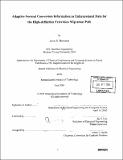Adaptive format conversion information as enhancement data for the high-definition television migration path
Author(s)
Thornbrue, James R. (James Raymond), 1976-
DownloadFull printable version (11.48Mb)
Alternative title
AFC information as enhancement data for the HDTV migration path
Other Contributors
Massachusetts Institute of Technology. Dept. of Electrical Engineering and Computer Science.
Advisor
Jae S. Lim.
Terms of use
Metadata
Show full item recordAbstract
Prior research indicates that a scalable video codec based on adaptive format conversion (AFC) information may be ideally suited to meet the demands of the migration path for high-definition television. Most scalable coding schemes use a single format conversion technique and encode residual information in the enhancement layer. Adaptive format conversion is different in that it employs more than one conversion technique. AFC partitions a video sequence into small blocks and selects the format conversion filter with the best performance in each block. Research shows that the bandwidth required for this type of enhancement information is small, yet the improvement in video quality is significant. This thesis focuses on the migration from 10801 to 1080P using adaptive deinterlacing. Two main questions are answered. First, how does adaptive format conversion perform when the base layer video is compressed in a manner typical to high-definition television? It was found that when the interlaced base layer was compressed to 0.3 bpp, the mean base layer PSNR was 32 dB and the PSNR improvement due to the enhancement layer was as high as 4 dB. Second, what is the optimal tradeoff between base layer and enhancement layer bandwidth? With the total bandwidth fixed at 0.32 bpp, it was found that the optimal bandwidth allocation was about 96% base layer, 4% enhancement layer using fixed, 16x16 pixel partitions. The base and enhancement layer video at this point were compared to 100% base layer allocation and the best nonadaptive format conversion. While there was usually no visible difference in base layer quality, the adaptively deinterlaced enhancement layer was generally sharper, with cleaner edges, less flickering, and fewer aliasing artifacts than the best nonadaptive method. Although further research is needed, the results of these experiments support the idea of using adaptive deinterlacing in the HDTV migration path.
Description
Thesis (S.M.)--Massachusetts Institute of Technology, Dept. of Electrical Engineering and Computer Science, 2003. Includes bibliographical references (p. 115-116).
Date issued
2003Department
Massachusetts Institute of Technology. Department of Electrical Engineering and Computer SciencePublisher
Massachusetts Institute of Technology
Keywords
Electrical Engineering and Computer Science.